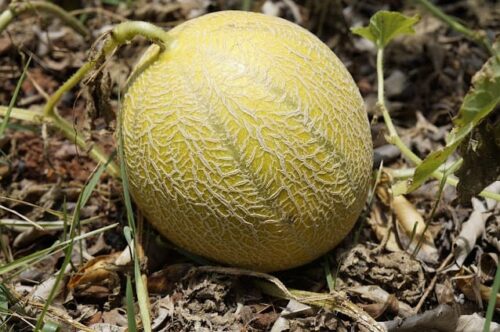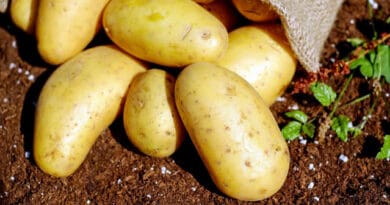Cultivation of Muskmelon in India; A full informational Guide
Cultivation of Muskmelon: A pleasant and hydrating fruit because of its high water content, especially in the hot summer months.
Muskmelon ( Cucumis melo. L. ) belongs to the family Cucurbitaceae. Muskmelon is an important crop cultivated throughout India. It is used as a dessert fruit and also eaten alone. It is rarely used as a cooked vegetable in its green stage.
Nutritive Value of Muskmelon:
The nutritive value of muskmelon in 100 g of the edible portion is given below:
| NUTRIENT | VALUE | NUTRIENT | VALUE |
| Moisture | 92.8 gms | Iron | 1.30 mg |
| Protein | 0.6 gms | Sodium | 4.60 mg |
| Fat | 0.1 gms | Potassium | 341 mg |
| Minerals | 0.6 gms | Copper | 0.03 mg |
| Fiber | 0.5 gms | Sulphur | 32.0 mg |
| Other carbohydrates | 5.4 gms | Vitamin A | 450 I.U. |
| Calories | 25 | Thiamine | 0.11 mg |
| Calcium | 65 mg | Riboflavin | 0.08 mg |
| Magnesium | 31 mg | Nicotinic acid | 0.05 mg |
| Phosphorous | 20 mg | Vitamin c | 32.0 mg |
Soil and climatic requirements for muskmelon cultivation
Sowing of Muskmelon seeds;
(a) Time of sowing. The seeds may be sown from November to March in the plains and April-May in the hills. The seed is sown in November or December in West Bengal. Bihar and South India. Transplanting of about a week-old seedling may also be done.
(c) Seed rate. The seed rate is 600 g per acre.
Suggest four methods of muskmelon planting as follows:
1. Shallow pit method
In this method, pits of 60 x 60 x 45 cm are dug at a distance of 1.5 to 2.5 meters. Each pit is filled with a mixture of soil and 4 to 5 kg of F.Y.M. or compost, 30 to 40 gm of urea, and 40 to 50 gm. Single superphosphate and 80 to 100 gm of murate of potash.
After filling the pit, circular basins are made, and five to six seeds are sown per basin at 2 to 3 cm deep and covered with fine soil, FYM, or compost.
2. Deep pit method
This method is followed in the riverbed cultivation. Circular pits of 60 to 75 cm diameter and 10 to 1.5 m depth are dug at a distance of 1.5 to 2.5 meters.
3. Ridge method The seeds are sown on the side of raised beds.
4. Mound beds: seeds are sown on the mounds. The seed rate is 1.6 kg per acre.
The normal spacing is row-to-row 300 cm and plant-to-plant 90 cm.
Germination percentage and the storage life of seeds can be improved by treating freshly extracted seeds with Trichoderma viride 4 grams or Pseudomonas fluorescens 10 grams, or 2 grams/kg of watermelon seeds.
Varieties of Muskmelon:
Hara Madhu; It is a late-maturing variety. Its fruits are larger in size and round in shape, with an average weight of approximately one kg. The skin of this variety is a light yellow color. and the TSS contains about 13%. Hara Madhu is very sweet. The flesh of this variety is green, thick, and juicy. Seeds are of small size. Hara Madhu is resistant to powdery mildew. It gives an average yield of 50 qtl/acre.
Punjab Hybrid; It is an early maturing variety. The fruit of this variety is round, light yellow colored with netted skin. The flesh is thick, orange in color, juicy, and of excellent flavor. · TSS is up to 12% and has an average weight of about 800 g. It is resistant to fruit fly and gives an average yield of 65qtl/acre.
MH-51; The MH-51 variety is released in 2017. The average yield of this variety is 90 Q/acre. Its fruit is round and has stripes, and is gauzy. It has 12% sucrose content.
F1-RUBY-903: · The size of this variety is about 1.25-1.5 kg, and it matures in·72-80 days from sowing. It has round fruit with thick netting, orange flesh, and good aroma, thick and very sweet flesh with a sugar content of about -14.5 % to 15%. The shelf-life of this variety is long.
MH-27; It was released in the year 2015. It gives an average yield of 90 Q/acre. It contains about 12.5% sucrose content.
Arka Jeet: It is an improvement over a local (IIHR 103) collection from Lucknow. It has an angular stem with dark green lobed leaves. The fruits of this variety are small, and the average fruit weight is about 350 g. Fruits are round but flat at both ends and have dark green skin at an early stage of fruit development, which turns into golden orange at the full stip stage. The flesh of this variety is white with a medium texture and excellent flavor with high TSS (13-16%), It is rich in vitamin C content (41.6 mg/100 g) The maturity period of this variety is 90 days, with a yield potential of 14–15 t/ha.
Other Promising Varieties of Muskmelon: Arka Rajhans, MH 10, Pusa madhurima, Pusa-Sarbati, Pusa Madhuras, Durgapura Madhu, Pusa Sundari, Lucknow Safed, Hari Dhari Faizabadi, Kutana, Amritsari, Annamalai, etc.
Exotic Varieties: PMR -45, Jacuba, Campo, etc.
Manuring in Muskmelon;
40 kg nitrogen, 20 kg phosphoric acid, and 20 kg potassium per acre are recommended for muskmelon farming. The suggested application of 1200 to 1400 kg of compost per acre, followed by 30 to 32 kg of Nitrogen, 20 kg of Phosphoric acid, and 20 kg of Potassium per acre for a good crop
By spraying boron at 50 and 75 ppm and manganese at 50 ppm, a high yield of muskmelon can be obtained
Intercultural Operation in Muskmelon;
Two to three shallow cultivations should be performed to control weeds during the early stages of growth. Thinning of plants is also done.
Irrigation in the muskmelon crop
Irrigation should be given every week during the summer days at the time of maturity; irrigation should be given when it is necessary. If the muskmelon crop is sown on the riverbeds, it does not need any irrigation. For good sweetness and flavor, irrigation should not be given 3-4 days before harvesting
Harvesting of Muskmelon;
Muskmelon fruits can be picked in about 110 days, depending upon variety and Agro-climatic conditions. The stage of maturity is generally judged by the change in the external color of the fruit, softening of the rind, and the development of the abscission layer. Please note that the stage at which the fruits are picked also affects the quality of the fruits; hence, muskmelons should be picked in time.
Yield of Muskmelon
The average yield is 5600 to 6500 kg per acre.




